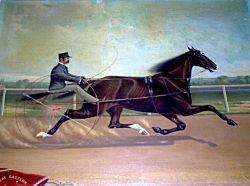Grant funding received for art conservation
September 13, 2007,from the Harness Racing Museum and Hall of Fame
Goshen, NY — From its humble beginnings along America’s country lanes and big city streets, the trotting sport (now known as harness racing) has become a passion for millions of fans around the world. The Harness Racing Museum & Hall of Fame, established in 1951, carries on the work of its founders, to preserve and celebrate the history of this American-born sport.
Today, as part of this ongoing effort, The Harness Racing Museum & Hall of Fame proudly announces receipt of a 2007 Conservation Treatment Grant from the Lower Hudson Conference of Historical Agencies & Museums (LHC), in association with the Museum Program of the New York State Council on the Arts (NYSCA), a state agency.
The Harness Racing Museum & Hall of Fame’s art collection includes one of the world’s largest compilations of Currier & Ives trotting horse lithographs and more than 160 oil paintings. Artists represented by the collection include 19th century masters Edward Troye and John McAuliffe, and turn of the century greats George Ford Morris and Gean Smith. Modern works, such as those of Richard Stone Reeves are also present, capturing today’s harness racing heroes for tomorrow.

The LHC award provides complete funding for the treatment of John McAuliffe’s portrait of the champion trotter Great Eastern pulling a high wheel sulky.
The LHC award of $4,620 provides complete funding for the treatment of New York artist John McAuliffe’s portrait of the champion trotter Great Eastern pulling a high wheel sulky. A self-taught artist, McAuliffe chose the sporting life as the primary subject of his work and became one of the most well known equine painters of his time.
America’s early sporting art reflected in many ways the European tradition of this form. Artists, often living itinerate existences, were commissioned by wealthy patrons to capture the likeness of horses and their owners and drivers. In capturing images of prized trotters, American artists not only projected the social position of a horse’s owner but also the growing social position of the breed. The establishment of the Standardbred as an iconic image of American sporting art both reflected and perpetuated the demand for this particular breed, whose offspring could not only carry the family to church but could also bring the excitement and pageantry of horse racing to everyday citizens.
Great Eastern was one of many champion trotters painted by John McAuliffe. Foaled October 10, 1869 in Rome, N.Y., a grandson of Hambletonian 10 — the great trotting sire of Chester, N.Y. — Great Eastern attained fame in 1876 at the height of McAuliffe’s career as an artist. During this period, McAuliffe painted such trotting men as General Ulysses S. Grant and J.P. Morgan astride their favorite mounts.
Great Eastern’s history is truly the tale of an overnight sensation. Viewed by his breeder as lacking in promise, the colt was raised to be a road horse, a strong, dependable but ignoble animal. No one suspected in those early days, the glory and success Great Eastern would have on the trotting track. It was not until 1874 that his owner, Mr. Hammill, recognized the horse was developing a stealing gait at the trot that, while appearing unhurried, carried them past other unsuspecting and slower horses on the road.
It was then that Mr. A.J. Feeks of Syracuse was chosen to take on the task of training the mammoth horse, who stood 17.2 hands high. His first appearance on the track was at Watertown, N.Y., on June 25, 1875, in which he took fourth place, setting his mile record of 2:30. The rest of the season passed without the horse lowering the record of that first race.
This inauspicious beginning promised little for the horse’s second season but in his first race of 1876 he took second place and in his second meet became famous. Great Eastern had never to this point beaten a 2:26 mile and with 11 horses entered in the field his chances of success seemed slim. Unexpectedly, Great Eastern began drawing away at the half-mile mark and continued to expand his lead, finishing four lengths in front and completing the mile in 2:19.
The horse that was first judged worthy of nothing more than to draw a common cart made history during the remainder of the season, winning against some of the greatest names in trotting.
Despite this success, Great Eastern faded again into obscurity but before doing so he was captured in his glory by one of the greatest equine artists ever to raise a brush. Now, with re-granted funds gratefully received from LHC in association with NYSCA’s Museum Program, the once threatened portrait of Great Eastern will be preserved, making it accessible to the public through future exhibition.
More information on this and other important restoration projects can be obtained by calling the museum’s director at (845) 294-6330 or stop by the museum to discover more about the fascinating history of harness racing as well as the museum’s educational programming and other services that support the sport. The museum, located at 240 Main Street in Goshen, N.Y., is open daily from 10:00 a.m.-5:00 p.m. There is no charge for admission, thanks to the support of The United States Trotting Association. Please call (845) 294-6330 for more information or visit our Web site at www.harnessmuseum.com.
